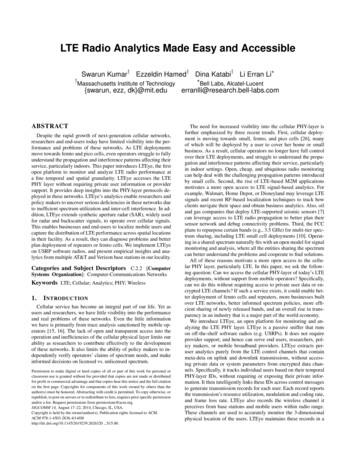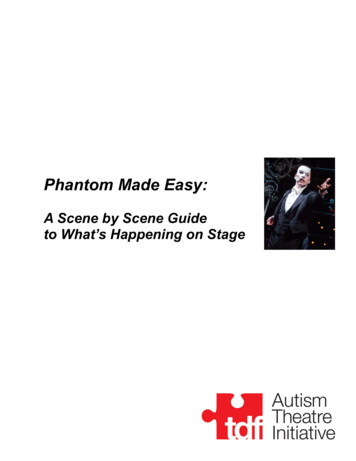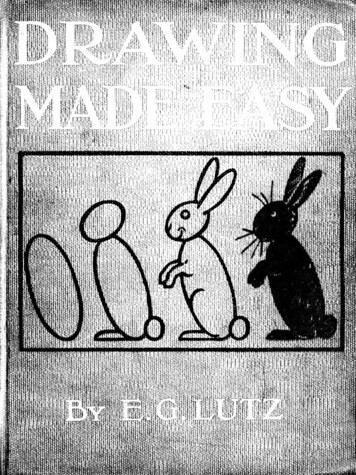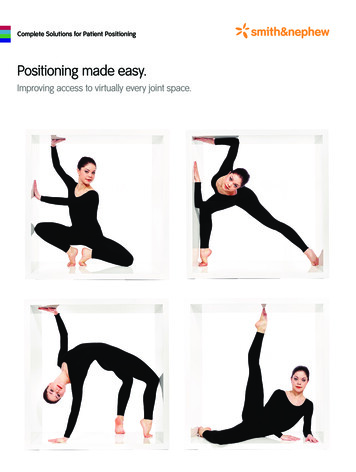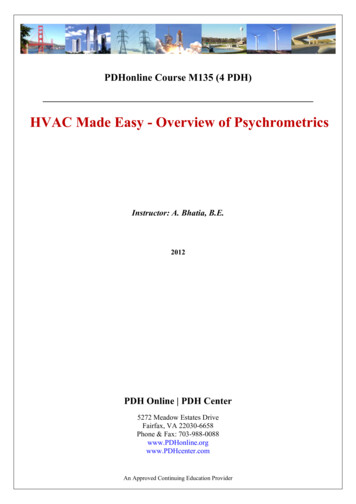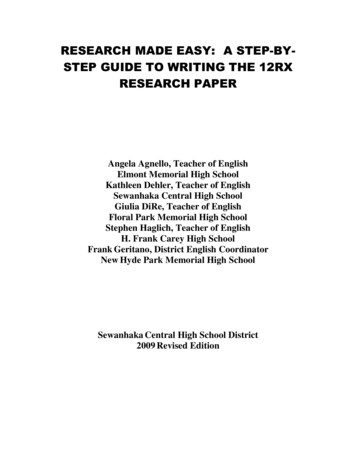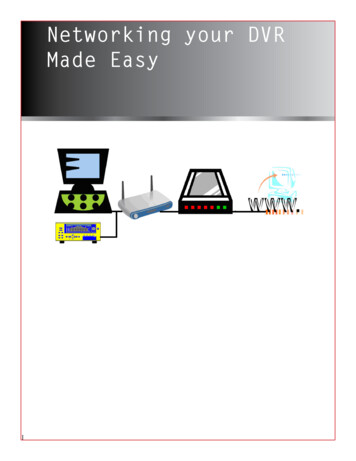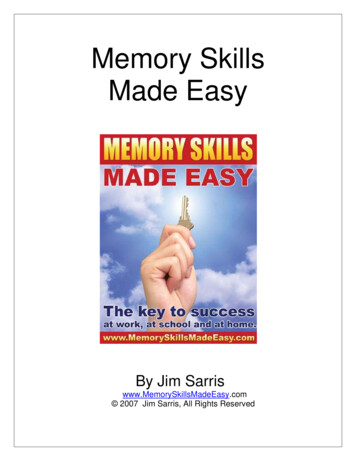
Transcription
Memory SkillsMade EasyBy Jim Sarriswww.MemorySkillsMadeEasy.com 2007 Jim Sarris, All Rights Reserved
Memory Skills Made EasyTable of ContentsChapter 1 Chapter 2 Chapter 3 Chapter 4 Chapter 5 Chapter 6 Chapter 7 Chapter 8 Chapter 9 Chapter 10 Chapter 11 Chapter 12 Chapter 13 Chapter 14 Chapter 15 Chapter 16 Chapter 17 Chapter 18 Chapter 19 Chapter 20 Chapter 21 Chapter 22 Chapter 23 -Introduction (p. 2)How the brain works (p.5)Visual or Auditory learner (p. 5)The role of anxiety and stress (p. 6)Your inner dialogue (p. 6)Visualization (p. 8)How to improve your memory starting today (p. 9)Memory strategy #1 – Acrostics (p. 12)Memory strategy #2 – Roman room (p. 18)Memory strategy #3 – Pegword (p. 28)Memory strategy #4 – Story/Link (p. 35)Memory strategy #5 – Chunking (p. 39)Memory strategy #6 – Keywords (p. 41)Memory strategy #7 – Making connections (p. 43)Remembering names (p. 44)Remembering PINS (p. 48)Remembering keys/wallet/cell phone (p. 49)Remembering where you parked your car (p.50)Locate misplaced items (p. 50)Reduce anxiety and remember more (p. 51)Random memory aids that work (p. 52)Attention and concentration (p. 53)Ways to help the brain along (p. 54) 2007 James Sarris. All Rights Reserved Worldwide2
Memory Skills Made EasyIntroductionWelcome to Memory Skills Made Easy. I’m so glad you’ve taken thestep to look at this program and learn how to easily improve yourmemory almost overnight.Did you know that nine out of ten people say they want to improvetheir memory? And that six in ten people say they walk into roomsfrequently and forget why?Well, you’re about to turn things around forever because I’m going toshow you some simple, yet effective ways to not only boost yourmemory in the short term but strengthen it for the long term.Naturally, I have my own stories of forgetting things. Like the time Ilocked the car and forgot I had the keys in the ignition with the carrunning!Now, if you were looking for a program that would make you a“Memory Whiz”, you’ve come to the wrong place. I am going to giveyou practical advice and know-how that you can use today to takecare of any memory task you’ll need. And if you decide you want tomemorize the phone book or 99 digits, then you can expand on thesesame methods and have a blast.Get ready to improve the quality of your life simply by improving thequality of your memory.The Rules Of The GameThe rules of the game if you want to improve your memory for real!Rule #1 – PAY ATTENTION!Follow this rule and you will improve your memory 25% without doinganything else. It is that simple. Get a quick 25% boost just by payingattention to the new information at hand, the person you are meeting,the words someone is saying, etc. 2007 James Sarris. All Rights Reserved Worldwide3
Memory Skills Made EasyDecide not to pay attention and no matter how much you enjoy thesetechniques, you will be in the same spot a month from now. No betterthan you are right now.Got it?Good.Rule #2 – You must get in the habit of engaging the material you aretrying to remember. By engaging, I mean you have to make an effortto connect with the material so that it can grab onto something in yourbrain.It could be through pictures, it could be through funny phrases, itcould be through movement.Regardless of your method, make sure it fits your learning style. Ifyou’re a person who says, “Listen, you need to hear the other side ofthe story,” then you are probably an auditory learner.If you usually say, “Look, you need to hear the other side of thestory,” then you are probably a visual learner.Don’t go the way of your friends or companions. Part of what I want toteach you in this course is to trust the way your own brain takes inand processes information. The goal is retention and recall.Rule #3 – Have fun and stay positive. Really, it’s important that youenjoy learning and see it as an opportunity to improve, to grow and tostay alive.People that stop learning, stop growing.Just think of a person that doesn’t exercise compared to one thatdoes. The person who doesn’t exercise has a harder time movingaround because the bones and muscles aren’t used to the activity.The person who does exercise has more bounce in their step andmore energy. 2007 James Sarris. All Rights Reserved Worldwide4
Memory Skills Made EasyYour brain is the same way when you don’t use it. Make thecommitment to work your brain daily and you’ll see a differenceguaranteed.How the brain worksWhat happens when you first hear a song on the radio you like?Since it’s the first time, you have an idea of how the song goes. Thenext time you hear it you listen a little closer and start to get thewords. By the third time, you have the melody and the words downand the song is in your head. You can hear it even when it’s notplaying on the radio.What happens with songs is what happens anytime you try toremember anything.First, you have to take in the data, in this case, hear the song.Naturally, you are paying attention to the song and so the data entereasily. When it comes to information for a test or a list of things to door the name of a new business associate, the same principle applies.You must be paying attention for the information to get in. Once itgets in, then you decide how important it is. If it is something youwant to remember long term, then, just like singing the song againand again, you can enter it into long term memory with rehearsal.If it’s something you only need for a short time, like a phone number,you forget it almost instantly.Visual or Auditory LearnerIt is very important to know how you learn.Visual learners like to look at maps when they are trying to locate anaddress. They also will read directions and picture in their minds therights and the lefts.Auditory learners like to read instructions out loud. They needsomeone to say it to them so they can make their pictures that way. 2007 James Sarris. All Rights Reserved Worldwide5
Memory Skills Made EasyWhat are you?Once you find out, stay in that mode.If you’re studying for exams and you’re a visual learner, drawdiagrams of wars, of the plot of the book you need to remember, ofthe steps of a science project.If you’re an auditory learner, say the steps of the procedure out loud(and then imagine them in your head). Say the parts of the plot outloud and see them in your head.You see, our brains use pictures to store information. You just haveto find the best way for you to create an image and then it’s stored.The role of anxiety and stressBelieve it or not, anxiety and stress are causing many of yourmemory problems.When you are overcome with worry about not remembering, yourbrain literally freezes up and can’t function. It is virtually impossible torecall what you need when you are stressed out.And of course, you become more stressed out when you can’tremember. We’ll go into stress reducers later in the course.Your inner dialogueListen to yourself the next time you sit down to study for a test. Or thenext time you look for your keys. Or the next time you forget aperson’s name and have to hide.Chances are you’re killing yourself mentally.“I can’t do this”“I have a terrible memory”“I can’t remember anything” 2007 James Sarris. All Rights Reserved Worldwide6
Memory Skills Made Easy“I’m worthless when it comes to remembering” and so on.You are taking yourself into a dark alley every time you have troubleremembering something and giving yourself a beating.THAT MUST STOP NOW!And here’s why.You will never improve your memory if you don’t believe it’s possible.Self-talk is very important to self-confidence and success.Now, I know what you’re thinking. You can’t talk about success untilyou have some.Well, believe it or not THAT’S WRONG!You read that right YOU’RE WRONG!You need to imagine success before you can experience it. This isthe secret behind all the great Olympic and professional athletes.They can spend almost as much time imagining their success as theydo training.And they haven’t run the race yet.Champions in all walks of life understand this and use it every day toachieve success others don’t.So here is what I want you to do if you are serious about improvingyour memory.Read the next chapter on visualization and follow the instructions for21 days. I guarantee you improve not only your memory but your selfesteem as well. 2007 James Sarris. All Rights Reserved Worldwide7
Memory Skills Made EasyVisualizationThere may be nothing more important to your success thanvisualization.I would read every word in this section carefully because it has thepower to change your life in many ways.You need to understand one thing If you don’t believe you can have a strong memory, youwon’t ever have a strong memoryStarting today, you MUST take time out, even if it’s only for a fewminutes, and see yourself as a person who can remember whatever itis you want to remember.Your mind must become accustomed to feeling successful and youdo that by creating images of success in your mind. In this case,success at remembering things.There have been many experiments done over the years that showthat the mind does not distinguish between a real event and animagined one.Decide what you want to improve and picture yourself going throughyour day doing that thing perfectly. PERFECTLY.Believe me when I tell you that you will become convinced that youremember things very well and the days of anger and frustration willbe over.Here’s how you do it:1) Find a comfortable place to sit.2) Make sure there are no distractions3) Set your alarm on your watch for 2 minutes (you can make itlonger as time goes on) 2007 James Sarris. All Rights Reserved Worldwide8
Memory Skills Made Easy4) Close your eyes and start your movie.See yourself doing the thing you want PERFECTLY! Use all yoursenses as you imagine. Feel the chair you’re sitting on in class, smellthe air in the room, touch the desk and your pen, hear the teachergive the instructions, taste the saliva in your mouth as you calmly waitfor the test to be handed out.It works! Believe me.How to improve your memory starting todayHere is what you need to do before you decide what area of memoryimprovement is most important.But it has to be the first step for any area you choose.Number one – Decide how you want to improve your memory.Do you want to do better on tests?Do you want to remember where your car keys are?Do you want to remember appointments? names? faces?Decide now what you want to improve. You can only do one thing ata time so make sure you choose the most important one.Number two – Write it down.Once you decide what you want to improve, write it down in a journal.Write down how your life if going to look once you are better at whatyou have chosen. How is your day going to be? What is it going tofeel like to master this one area of your life.Number three – Imagine yourself doing what you’ve chosen toimprove.This part is very important. You have to take a few minutes everyday(in the beginning) and imagine yourself doing exactly what you wantto improve. Imagine the moments that now cause you stress with thisarea. You’re going to picture these moments in a different way now. 2007 James Sarris. All Rights Reserved Worldwide9
Memory Skills Made EasyYou’re going to see positive results and feel positive energy as youimagine these same moments.You see, your thoughts can control how things turn out. If you arepositive and can see positive results, then you will get them. If youpicture only negative results, then you’ll get them.Let’s see how this applies to small things.Ex. Remembering where you put your keysYou’ve decided to conquer your frustration with putting your keysdown and not finding them.Step 1. Defining what you are going to improve.You are going to remember where you put your keys.Step 2: Writing down how things will look once you conquer thisfrustration.Your entry will look something like this:“I wake up in the morning, get dressed and see my car keys in thesame place everyday. They are next to the coffee cups. I leave themnext to the coffee cups as soon as I walk in the door and they arethere waiting for me when I need them. I’m calm each morningbecause I know when I need to get my keys they are right where theyneed to be. It feels great knowing I can find them every time.”Step 3: Imagining life remembering where you put things.Let’s continue with remembering the car keys.You see yourself in the morning, you’re dressed, you’ve finished yourcoffee, you see the clock and realize you have to leave, and theykeys are right next to the coffee cups. You calmly grab them and walkout the door. 2007 James Sarris. All Rights Reserved Worldwide10
Memory Skills Made EasyWhen you return, you go right to the coffee cups and leave the keysnext to them, confident that they are safe and will be waiting for youwhen you return.That is the first step to improving your memory in any area.Important points Have a memory spot – the coffee cups become your memoryspot. Put the things there each time until it becomes a habit.Have as many memory spots as possible. Remember that changes take time. You have to develop newhabits. I’ve always heard that you need to do something for 21days before you do it automatically. For example, if you alwaysput on your right shoe first, and you wanted to start putting onyour left shoe, you would need to do it for 21 days before itbecame something you did automatically, without thinking. 2007 James Sarris. All Rights Reserved Worldwide11
Memory Skills Made EasyStrategy # 1 - AcrosticsOne method that works very well is called acrostics. It takes the firstletter of a series of words and makes a sentence out of it. Sometimes the sentence is funny but sometimes not.It is ideal for the auditory learner. If you like sounds and like to hearthings spoken in order to remember them, you are in luck. This is themethod for you.Here is a famous example: My Very Educated Mother Just Served Us Nuggetso (Mercury, Venus, Earth, Mars, Jupiter, Saturn,Uranus, Neptune)My very educated mother just served us nuggets, which is theacrostic to remember the order of the planets from Mercury toNeptune.All someone did a long, long time ago was take the first letter of eachitem and make a sentence out of them.Acrostics and How They WorkLet’s go ahead and create a sentence on our own. We’ll keep itsimple at first.Let’s memorize the order of bones in the spinal column. They are:Cervical, Thoracic, Lumbar, Sacrum, CoccyxThe first letters of each one are:CTLSCWhat we are going to do is take the first letter of each name andcreate a sentence that we like and can easily remember. 2007 James Sarris. All Rights Reserved Worldwide12
Memory Skills Made EasyFor this example, I’m going to create a sentence so you can see howit works.Once you start to do this on your own, you’ll get very good at comingup with sentences that you like.Here are some attempts I made before I decided on one I liked:Cervical, Thoracic, Lumbar, Sacrum, CoccyxCTLSC- Can Turtles Leave School Calmly? – so-so- Charlie Touches Larry’s Spinal Column – not bad- Charlie Takes Larry’s Spinal Column – I like thisone.Here are some tips:1) Try a couple of combinations - Keep playing with it until you come upwith one you like and can remember.2) Check to see if order is important – If the words need to be in a certainorder, then memorize them as is. If you are memorizing a group, thenmove the letters around and create an even better mnemonic.3) Be familiar with the material - You will always remember easier if youhave seen the material in your studies. In this case, if you didn’t alreadyknow the names of the bones it would be difficult to remember them justby looking at a letter.4) Tie the sentence to an image – It’s real important to connect thesentence to a picture that reminds you of the topic. In this case it’s thebones of the spinal column.This is what I mean. Your brain always remembers better whenthere’s a picture or visual attached.So, this is pretty simple. Let’s imagine Charlie running away fromLarry with the spinal column in his hands. We see Larry’s back withno spinal column. He’s screaming, “Hey, give me back my spinalcolumn!”Sound crazy? That’s fine. You’re giving your brain what it likes.Alright, now let’s see how this can help us later on. 2007 James Sarris. All Rights Reserved Worldwide13
Memory Skills Made EasyLet’s imagine we need to remember the bones of the spinal column.Well, once we say spinal column, the image of Charlie taking Larry’sspinal column comes to our minds and we say, oh yeah, “Charlie –Cervical, takes – thoracic,” etc.See how it works? Ok, now you’re going to come up with one on yourown.Creating Your Own AcrosticLet’s say you want to remember the functions of blood (I told youthese techniques could be used for anything!).They are: Oxygen, Carbon Dioxide, Food, Heat, Waste,Hormones, Disease, Clotting. And the letters are – OCFHWHDCNow, here’s the deal DON’T STARE AT THE LETTERS AS YOUCREATE YOUR MNEMONIC! 2007 James Sarris. All Rights Reserved Worldwide14
Memory Skills Made EasyOCFHWHDCStare at the words in particular, the first letter of each word.Oxygen, Carbon Dioxide, Food, Heat, Waste,Hormones, Disease, ClottingThis helps you learn the list even better as you create yourmnemonic.Here’s my sentence: Old Charlie Fights Heavy Women Holding Dirty ClothesNot bad if I do say so myself!Take a look at the possibilities below and expand your use ofacrostics NOW!Biology To remember the classification of living things – Kingdom, Phylum,Class, Order, Family, Genus, Species, Variety – KPCOFGSVo Kings Play Cards On Fairly Good Soft VelvetTo remember the functions of blood – Oxygen, Carbon Dioxide,Food, Heat, Waste, Hormones, Disease, Clotting – OCFHWHDCo Old Charlie Fights Heavy Women Holding Dirty ClothesMusic To remember the order of notes on the bass clef – GBDFAo Golf Balls Don’t Fly AwayTo remember the circle of fifths – FCGDAEBo Fat Cats Go Down Alleys Eating BirdsGeology To remember Moh’s hardness scale – from softest to hardest –Talc, Gypsum, Calcite, Fluorite, Apatite, Orthoclase, Quartz, Topaz,Corundum, Diamondo Tall girls can fly and only quit to catch diamondsChemistry 2007 James Sarris. All Rights Reserved Worldwide15
Memory Skills Made Easy History To remember the diatomic elements in the periodic table besidesthe noble gases (Group 18). They are: Bromine, Iodine, Nitrogen,Chlorine, Hydrogen, Oxygen, and Fluorineo Boys In Night Class Have Odd FriendsTo remember the Paleozoic period – Cambrian, Ordovician,Silurian, Devonian, Carboniferous, Permian.o Cats Often Sit Down, Carefully PurringMath Physics To remember the basic trigonometric functions – Sine(opposite/hypotenuse), Cosine (adjacent/hypotenuse), Tangent(opposite/adjacent)o Old Houses Are Houses Of Age (Sine, cosine and Tangentare always addressed in the same order)To remember the alkali metal group - Lithium (Li), Sodium (Na),Potassium (K), Rubidium (Rb), Caesium (Cs), Francium (Fr).o Little Nancy Kept Rubies in Caesar’s Front-pocketSpanish To remember irregular verbs in the past tense that change theirstem and have no accents – Poner, Poder, Querer, Venir, Tener,Saber, Hacer, Conducir, Estar, Decir, Traer.o Peter Pan Quit Volleyball Training So He Could Eat DinnerTonightApplying Acrostics to the real worldLet’s think for a minute how we can apply this technique to the realworld.Here are some of the areas that come to mind: To-do lists Grocery lists People to buy presents for People to invite to a party.the list could be endless. Just make sure you come up with a phrasethat you like and is memorable.Other ways of handling short lists 2007 James Sarris. All Rights Reserved Worldwide16
Memory Skills Made EasyAcronyms – Use the first letter of each item and create a word. If youneed to buy Christmas presents for your friends Peter, Pedro,Angela, Eric, Robert, you have the letters “PPAER”. Change themaround and you have “PAPER”. Now, you remember Paper andyou’re on your way.Rhymes – Try buying ham, cheese, pizza, orange juice andstrawberry jam. How about “A cheese pizza with ham, topped with OJand strawberry jam.” 2007 James Sarris. All Rights Reserved Worldwide17
Memory Skills Made EasyStrategy # 2 - The Roman RoomThink of your favorite room in your home.Close your eyes and imagine that room.you’re at the door and youlook from left to right. Look for 10 things that stand out: if it’s abedroom, choose the bed, the dresser, a mirror, a closet, a poster, achair Now, take a moment and write down these objects on a piece ofpaper. Focus on what you’ve chosen.All set. OK, just take another moment and go around your room againbut this time in your mind and look closely at the objects you’vechosen.Great.What you’ve done is what the ancient Romans would do thousands ofyears ago.You’ve created places where you can put your information and recallit instantly.It sounds tricky but once you see it you’ll get the idea.We are going to remember the first 10 states to ratify the constitutionof the United States.They are: DelawarePennsylvaniaNew JerseyGeorgiaConnecticutMassachusettsMarylandSouth CarolinaNew Hampshire 2007 James Sarris. All Rights Reserved Worldwide18
Memory Skills Made Easy VirginiaBefore we begin, you need to know that the Romans used to walkaround the rooms they chose a few times so that they would easilyremember the objects.You haven’t done that so if you get stuck remembering the object,just look at the sheet where you have them written down.Also, this is going to take more time than it normally will because I amgoing to explain each part slowly. Once you do this on your own youwill fly through it in no time.Just remember one thing: YOU MUST STOP FOR AT LEAST 3SECONDS AND REALLY SEE THE IMAGE. IF YOU DON’T, YOUWON’T REMEMBER.Let’s begin.Our first state is Delaware. What sound jumps out at you when yousay Delaware? We are going to use that sound to create a keyword.That word will remind us of the state.Delaware Delaware for me it’s DELL so I’m going to choose Dellcomputers as my keyword.Now, let’s create a picture of a Dell computer with our first object.Think in your mind of your room and imagine a nice Dell computer onyour object shiny black, with a brand new keyboard and flat screenmonitor sitting on top of our first object. We see the name Dell on thescreen with the E spelled at an angle. 2007 James Sarris. All Rights Reserved Worldwide19
Memory Skills Made EasyLater, when we come back to this object, we’ll picture the Dellcomputer and that will lead us to Delaware. Let’s continue.The next state is Pennsylvania.What sound jumps out at you when you say Pennsylvania?How about a pencil?So pencil will be our keyword, the word that helps us rememberPennsylvania.Let’s create a picture of our object and a pencil. I imagine a bigpencil, I mean a big as you. And you are holding this pencil with twohands trying to write something on your object but it’s too heavy soyou put it down next to your object.(No picture this time!.It’s time to create your own!)Later, when we come back to this object, we’ll picture that big penciland that will lead us to Pennsylvania.The next state is New Jersey.What sound jumps out at you when you say New Jersey? Well, thisone seems kind of easy to me.How about a new sports jersey? Of your favorite team? 2007 James Sarris. All Rights Reserved Worldwide20
Memory Skills Made EasySo jersey will be our keyword, the one that helps us remember NewJersey.Let’s create a picture of your object and a jersey you have in mind. (Ifyou don’t have a favorite sports team, think of your favorite jersey thatyou wear when it’s cold outside).I imagine a jersey of my favorite team on a hanger hanging from myobject. It still has the price on it but it looks brand new with my nameon it and I’m dying to wear it.Later, when we come back to this object, we’ll be able to picture thejersey and that will lead us to New Jersey.The next state is Georgia.What sound jumps out at you when you say Georgia?For me it’s the name George. Well, I can’t remember the nameGeorge but I can remember the name George Washington. And I candefinitely remember a big dollar bill, the kind you find in carnivals.Usually they’re million dollar bills. I can see George’s face on them.So, let’s create a picture of your object and a huge dollar bill. Iimagine a huge dollar bill glued to my object. I see George’s facestaring right at me.Later, when we come back, we’ll see the dollar bill and rememberGeorge Washington and then get to Georgia.The next state is Connecticut.What sound jumps out at you when you say Connecticut?For me it’s connect. And I immediately think of connect the dots. Youknow where you have a bunch of dots on a piece of paper and youand your friend start to connect them one at a time. 2007 James Sarris. All Rights Reserved Worldwide21
Memory Skills Made EasySo, let’s create a picture of your object and a bunch of sheets withconnect the dot games on them.I imagine loose leaf paper that has scotch tape at the top holding it tomy object and on the paper are a whole bunch of connect the dotgames ready to be played.OK, we’ve done half of the states and it’s taken awhile because I’mexplaining the process slowly. But let’s just see how we’ve done sofar.Let’s try to remember the states. You can either look at the list ofobjects on your paper or picture them in your mind.Think of object number one – think of the picture, think of the keywordand then remember the state.Dell computer DelawareNow, think of object number two – think of the picture, think of thekeyword and then, remember the state.Do the next three on your own.Now we have a good sense of the power of the Roman Room andhow we can construct it so let’s try and simulate how you would reallydo it without so many comments from me. JUST REMEMBER TOREALLY PICTURE THE IMAGE!The next state is Massachusetts.What sound jumps out at you when you say Massachusetts?How about the word chew?Let’s picture a dog chewing on our next object. You see the teethmarks already and he keeps chewing away. Even if your object ismetal, this dog is hungry. 2007 James Sarris. All Rights Reserved Worldwide22
Memory Skills Made EasyThe next state is Maryland.What sound jumps out at you when you say Maryland?Hum.this isn’t so easy. Let’s get something close. How aboutmarried?Let’s picture a newly married couple holding your next object. Yousee the bride with the object in her hands (or if it’s a closet, they arestanding next to it) and the groom is the same way. Don’t worry aboutwhy a newly married couple is in your room holding your object.Remember wacky is good!The next state is South Carolina.What sound jumps out at you when you say Carolina?How about caroling? You know, at Christmas time.So let’s picture a whole bunch of people dressed not in winter clothesbut in bathing suits, with towels around their necks. Remember, thiswill help us remember South Carolina. They have their song books intheir hands singing next to your next object.The next state is New Hampshire.What sound jumps out at you when you say New Hampshire?How about a hamster?So let’s picture a bunch of cages of hamsters on top of the objectrunning as fast as they can on that wheel they have. It’s making a lotof noise because they are going so fast.The last state is Virginia.What sound jumps out at you when you say Virginia?How about the gingerbread man? 2007 James Sarris. All Rights Reserved Worldwide23
Memory Skills Made EasyLet’s picture the gingerbread man from the movie Shrek standingnext to the last object. Big and brown, with the cream for lips andeyes. He has the object in his hand and he’s throwing it up in the air.Great job! Now let’s review.You can either look at the list of objects on your paper or picture themin your mind.Think of the first object - think of the keyword and then think of thestate. DelawareNow, think of next object - think of the keyword and then think of thestate.You should see that the states come to you with little or no effort. It alldepends on how clearly you saw the image in your mind.If you really got it the first time, then begin thinking of places to use itin your studies. If you’re still not sure, I’ve included another examplelater on in the guide book. You can try it out on your own.The most important thing is that you use the same objects again andagain so that you become comfortable seeing them and puttingpictures of things on them.Tips: Don’t be intimidated. Once you use it once or twice, you’llfeel comfortable with the objects you choose and it will takeno time at all. Expand this method for more than 10 things. Just useanother room with 10 different things. Or add more objects tothe room you’re using. Label each trip through your room. Like all the othermnemonics, label the trip, tie an image to the process so youcan recall it easier 2007 James Sarris. All Rights Reserved Worldwide24
Memory Skills Made EasyIn this case, since we are remembering the states that ratified theconstitution, picture a big piece of paper on a table in the middle ofthe room (it says at the top, THE CONSTITUTION) and a bunch ofmen dressed like in 1787 yelling, “I want to ratify first.no me first.”Ideas for using the Roman RoomRemember that the Roman Room can be used for any long list thatdoesn’t have to be memorized in order.That can include things like: Lists fromo Science – the bones, the organ system, etc.o Math – prime numbers, laws of Geometry, etc.o History – states, capitals, etc.o English – Conjunctions, prepositions, essays, etc.o Foreign Language – irregular verbs, essays, etc.Remembering Speeches or Presentationswith the Roman RoomThere is only one way to remember a speech so that you have itdown cold. I mean without fail, no sweat, a piece of cake.It was used by the biggest and baddest storytellers the world hasever seen. The people that needed to remember up to 500 differentstorie
Memory Skills Made Easy Visualization There may be nothing more important to your success than visualization. I would read every word in this section carefully because it has the power to change your life in many ways. You need to understand one thing If you don’t believe you can



